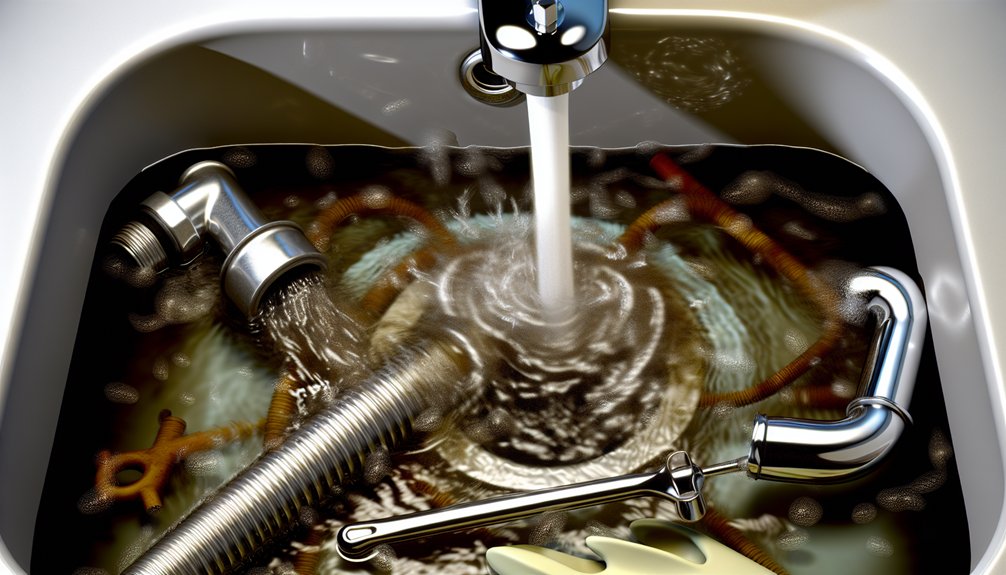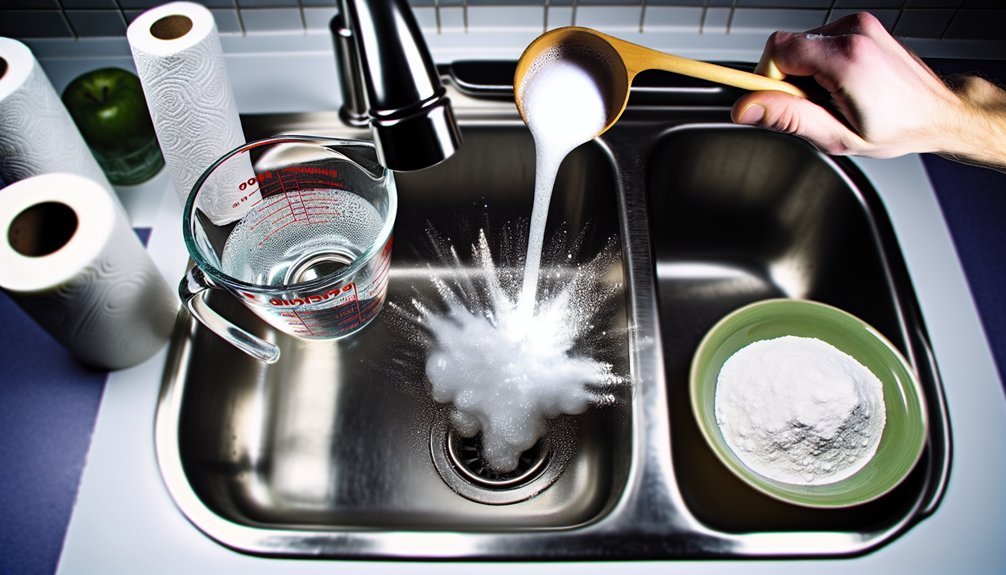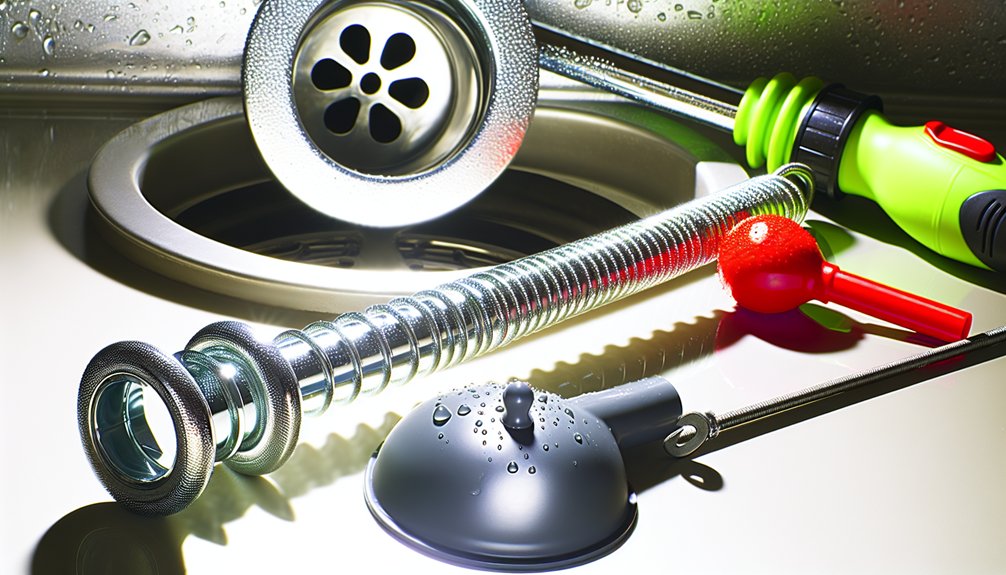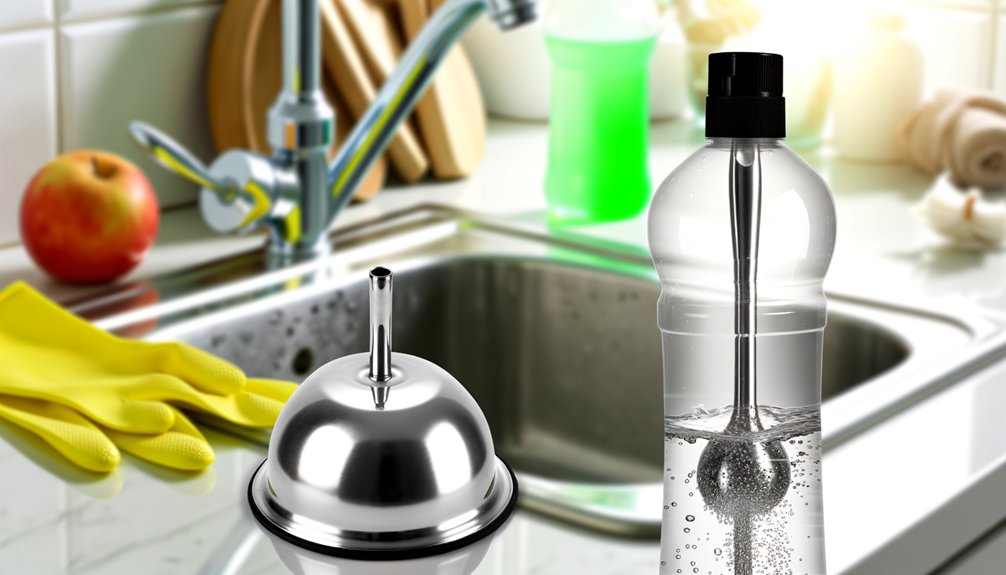To clear drain blockages easily, one must first assess the clog's severity. Start with the boiling water method to dissolve grease and food buildup. If necessary, use a baking soda and vinegar solution for chemical action. Employ a plunger to create suction for stubborn clogs. Mechanical tools such as drain snakes and augers can reach deeper blockages. Additionally, a wet and dry vacuum can effectively remove debris. Regular maintenance practices are essential for preventing future issues. Further techniques could enhance efficiency.
Assess the Severity of the Clog

How can one accurately evaluate the severity of a clog? The evaluation begins with observing symptoms such as slow draining, gurgling sounds, and foul odors, which provide critical insight into the clog's nature. Minor clogs often present as slow-draining sinks or tubs, while major clogs can lead to overflowing water or complete blockage. The location of the clog plays a pivotal role; those near the drain entry can typically be addressed with straightforward DIY techniques. Conversely, deeper clogs might necessitate specialized tools or professional intervention. Identifying the materials causing the clog—be it hair, grease, or food particles—offers additional clarity, enabling the selection of the most effective unclogging method. Persistent issues that resist initial treatments may indicate underlying plumbing issues, warranting further inspection. By carefully evaluating these factors, one can take informed steps toward liberation from drain blockages.
Boiling Water Method
The boiling water method serves as a practical and effective solution for addressing minor drain clogs. By pouring approximately 1/2 gallon of boiling water directly down the clogged drain, individuals can dissolve and dislodge blockages caused by grease, soap scum, and food particles. This technique is particularly useful in kitchen sinks where such clogs frequently occur.
However, caution is advised with PVC pipes, as high temperatures may risk melting or damaging them. Instead, using hot tap water is a safer alternative for these materials. For best results, following the boiling water with hot tap water for about five minutes enhances the drain cleaning process, keeping the drain clear and preventing future clogs.
| Issue | Recommended Action | Notes |
|---|---|---|
| Grease | Use boiling water | Effective for dislodging |
| Food Particles | Pour hot water to clear | Common in kitchen sinks |
| PVC Pipes | Avoid boiling water | Risk of damage |
Baking Soda and Vinegar Solution

Following the boiling water method, another effective approach for clearing minor drain blockages involves a combination of baking soda and vinegar. This natural and cost-effective solution leverages a chemical reaction that generates carbon dioxide, aiding in the dislodgment of debris within a clogged drain. To implement this method, one should first introduce one cup of baking soda into the drain, followed by two cups of vinegar. The ensuing bubbling reaction is critical for breaking down blockages. It is advisable to cover the drain after adding vinegar, allowing the mixture to sit for 5 to 10 minutes for maximum efficacy. Subsequently, it is important to flush the drain with boiling water to wash away the loosened material and guarantee clear passage. Incorporating this baking soda and vinegar solution into regular drain cleaning routines serves as an effective preventive measure against standing water and future clogs.
Using a Plunger
Using a plunger effectively requires proper technique and conditions to maximize its unclogging capabilities. A plunger serves as a powerful tool for addressing clogged drains and restoring water flow. The following steps outline the effective use of a plunger:
- Confirm that there is sufficient standing water in the sink or tub to cover the plunger's rubber head, creating a tight seal.
- Position the plunger over the drain and push down firmly to expel air before quickly pulling up to create a vacuum effect that dislodges the blockage.
- Repeat the plunging motion vigorously for 15-20 seconds, which aids in breaking up the clog and improving drainage.
- For stubborn blockages, continue plunging while maintaining the seal to optimize suction.
After successfully clearing the drain, it is advisable to flush it with hot water to eliminate any residual debris, confirming a clear passage for draining water.
Mechanical Tools for Clog Removal

After addressing minor clogs with a plunger, more complex blockages may require the use of mechanical tools specifically designed for effective removal. Tools such as a toilet auger and drain snake are essential in tackling stubborn clogs. A toilet auger is engineered to navigate bends in toilet plumbing, preventing pipe damage, while a plumber's snake extends several feet into the system to reach deeper drain blockages. The ZipIt tool is a disposable drain snake ideal for extracting hair and debris from sinks and showers without cumbersome equipment.
| Tool | Description |
|---|---|
| Toilet Auger | Designed to clear toilet clogs without damage. |
| Drain Snake | Extends deep into plumbing for tough clogs. |
| ZipIt | Small tool for hair and debris in sinks. |
| Closet Auger | Flexible cable for tight spaces in toilets. |
Regular use of these mechanical tools can maintain clear drainage, preventing severe plumbing issues.
Wet & Dry Vacuum Technique
The wet and dry vacuum technique requires meticulous setup to guarantee effective clog removal. It is essential to switch the vacuum to wet mode and establish a tight seal between the vacuum's arm extension and the drain to optimize suction. Prior to activation, removing visible debris and emptying the collection tank will greatly enhance the vacuum's performance during the unclogging process.
Proper Setup Procedure
A successful setup procedure for clearing drain blockages with a wet & dry vacuum involves several critical steps to confirm efficiency and effectiveness. To guarantee peak performance, one must adhere to the following:
- Set the wet & dry vacuum to wet mode to manage liquid obstructions effectively.
- Create a tight seal between the vacuum's hose and the clogged drain, utilizing an adapter if necessary, to maximize suction.
- Activate the vacuum, allowing it to run for several minutes while monitoring for any signs of the clog being cleared.
- Securely position the vacuum to prevent spills or messes, especially when dealing with large volumes of debris.
Afterward, check the collection tank for debris, cleaning or emptying it as needed to maintain peak performance.
Effective Suction Techniques
Utilizing effective suction techniques is critical when addressing drain blockages with a wet and dry vacuum. First, set the vacuum to wet mode to remove water sitting in the local drain. Creating a tight seal between the vacuum hose and the drain opening maximizes suction power, preventing air leaks. Once secured, turn on the vacuum to initiate suction, aiming to extract the clog while monitoring for flow changes. It is vital to use a vacuum designed for wet applications to avoid damage and maintain safety. If the initial attempt does not clear a clogged drain, repeating the suction process multiple times can yield better results, potentially eliminating the need for drain cleaners or using a plunger.
Regular Maintenance Practices
Effective regular maintenance practices are vital for guaranteeing clear drains and preventing blockages. Implementing these strategies can greatly reduce the risk of drain clogs:
- Flush drains with boiling water regularly to dissolve grease and food particles.
- Install drain strainers in sinks and showers to capture hair and debris, minimizing buildup.
- Schedule professional drain cleaning at least once a year to eliminate mineral buildup and avert serious clogs.
- Educate household members about avoiding the disposal of non-degradable items, such as sanitary products and wipes, which can lead to a blocked drain.
Additionally, regularly cleaning the siphon or P trap under sinks is essential for maintaining clear drainage paths. By adhering to these practices, homeowners can guarantee peak functionality of their plumbing systems while preventing inconvenient and costly blockages.
Frequently Asked Questions
What Is the Fastest Way to Clear a Clogged Drain?
Approximately 80% of clogged drains can be resolved using DIY methods. The fastest way to clear a clogged drain involves utilizing plumbing tools like plungers or drain snakes, in conjunction with natural remedies such as baking soda and vinegar. For tougher blockages, chemical solutions like liquid drain cleaners may offer swift results. Regular maintenance tips, including frequent drain cleaning, can help prevent future issues, while professional services are available for persistent problems.
How Do You Unblock a Severely Blocked Drain?
To unblock a severely blocked drain, various drain cleaning techniques can be employed. Utilizing plumbing tools such as plungers or plumber's snakes offers effective DIY solutions. For persistent issues, chemical remedies might be necessary, but caution is advised. Understanding common causes of blockages can aid in applying preventive measures. If these methods fail, seeking professional services is recommended to guarantee proper resolution and avoid further complications in the plumbing system.
How Do You Unblock a Drain Easily?
Research indicates that nearly 80% of drain issues stem from improper maintenance. To unblock a drain easily, individuals can employ several drain maintenance tips, such as using homemade drain cleaners like baking soda and vinegar. Utilizing plumbing tools, such as plungers and drain snakes, proves effective. Implementing effective drain cleaning techniques alongside prevention strategies can mitigate common drain issues, while eco-friendly solutions reduce the environmental impact. Regular maintenance guarantees peak drainage performance.
What Is the Best Remedy for Blocked Drains?
The best remedy for blocked drains combines natural remedies and plumbing tools. A mixture of baking soda and vinegar creates a powerful fizzing action, effectively breaking down minor clogs. For enhanced results, incorporating essential oils may provide pleasant scents. DIY solutions also include regular maintenance tips, such as pouring boiling water to prevent buildup. Utilizing proper plumbing tools, like plungers, guarantees thorough dislodging of clogs, promoting ideal drainage efficiency and longevity of the plumbing system.



